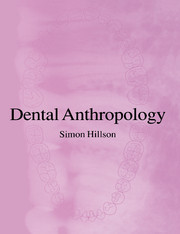Book contents
- Frontmatter
- Contents
- Acknowledgements
- Abbreviations
- 1 Introduction to dental anthropology
- 2 Dental anatomy
- 3 Variation in size and shape of teeth
- 4 Occlusion
- 5 Sequence and timing of dental growth
- 6 Dental enamel
- 7 Dentine
- 8 Dental cement
- 9 Histological methods of age determination
- 10 Biochemistry of dental tissues
- 11 Tooth wear and modification
- 12 Dental disease
- 13 Conclusion: current state, challenges and future developments in dental anthropology
- Appendix A: Field and laboratory methods
- Appendix B: Microscopy
- References
- Index
1 - Introduction to dental anthropology
Published online by Cambridge University Press: 05 June 2012
- Frontmatter
- Contents
- Acknowledgements
- Abbreviations
- 1 Introduction to dental anthropology
- 2 Dental anatomy
- 3 Variation in size and shape of teeth
- 4 Occlusion
- 5 Sequence and timing of dental growth
- 6 Dental enamel
- 7 Dentine
- 8 Dental cement
- 9 Histological methods of age determination
- 10 Biochemistry of dental tissues
- 11 Tooth wear and modification
- 12 Dental disease
- 13 Conclusion: current state, challenges and future developments in dental anthropology
- Appendix A: Field and laboratory methods
- Appendix B: Microscopy
- References
- Index
Summary
‘Show me your teeth and I will tell you who you are’, Baron Georges Cuvier, the great eighteenth–nineteenth century zoologist and anatomist, is supposed to have said. This comment was really in the context of comparative anatomy, and refers to Cuvier's delight in reconstructing whole extinct animals from fossil fragments of their dentitions, but it will do just as well for human teeth. For anthropologists studying archaeological, fossil and forensic remains, the teeth are possibly the most valuable source of evidence in understanding the biology of ancient communities, following the course of evolution and identifying an individual from their fragmentary remains. Dental anthropology might therefore be defined as a study of people (and their close relatives) from the evidence provided by teeth. Teeth have a distinct anatomy and physiology, all their own and wholly different to the biology of the skeleton, and teeth are also unique amongst the resistant parts of archaeological and fossil remains in having been exposed on the surface of the body throughout life. Dental anthropology can therefore be studied in the mouths of living people, using much the same techniques as are employed for ancient remains. It is thus not surprising that practising dentists have always been prominent amongst dental anthropologists, with anatomists and other oral biologists from schools of dentistry, in addition to researchers whose training lies more in biological anthropology. The exposure of teeth in the living mouth is also very useful when training anthropologists, as everyone carries their own reference material with them – students can just open their mouths and look in a mirror.
- Type
- Chapter
- Information
- Dental Anthropology , pp. 1 - 5Publisher: Cambridge University PressPrint publication year: 1996



